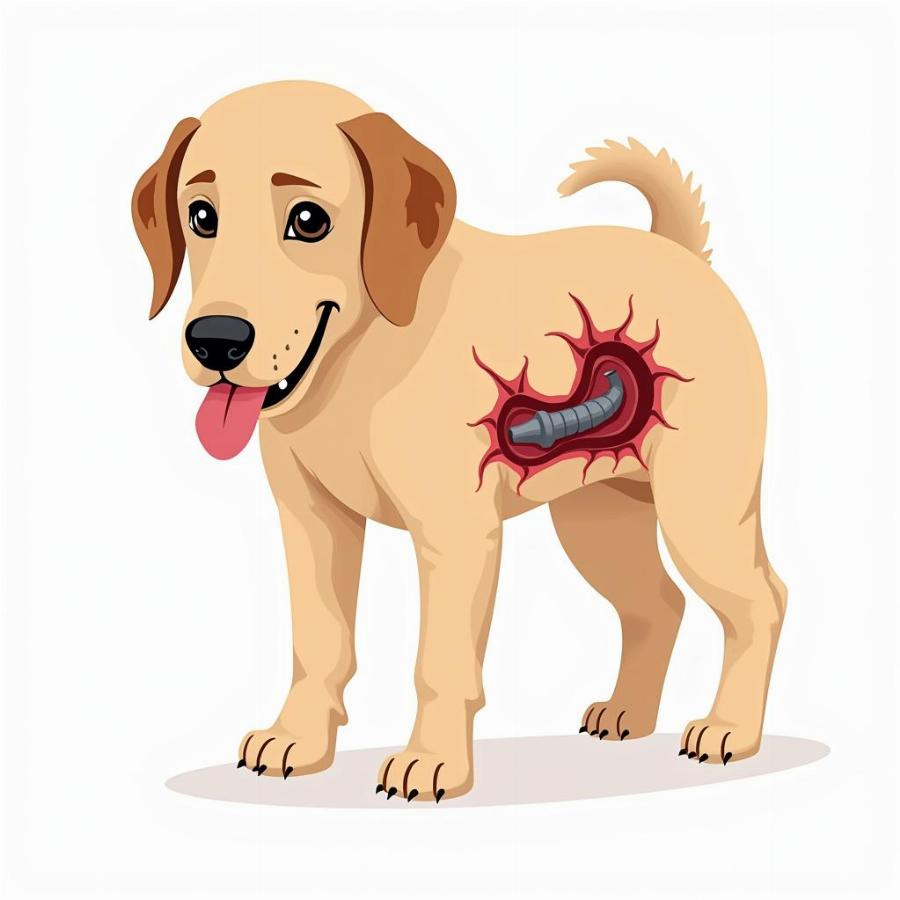Blockage in dogs, also known as intestinal obstruction, is a serious and potentially life-threatening condition that occurs when a foreign object obstructs the digestive tract, preventing food and fluids from passing through. This article will delve into the causes, symptoms, diagnosis, treatment, and prevention of blockages in dogs, equipping you with the knowledge to keep your furry friend safe and healthy.
Understanding Blockage in Dogs
Imagine a tube carrying essential nutrients; now picture something blocking that tube. That’s essentially what happens during a blockage in a dog’s digestive system. This blockage can occur anywhere along the digestive tract, from the stomach to the intestines, and can be partial or complete.
 Dog Stomach Blockage Illustration
Dog Stomach Blockage Illustration
Causes of Blockage in Dogs
Dogs are naturally curious creatures and often explore the world by putting things in their mouths. While this inquisitiveness is generally harmless, it can sometimes lead to them ingesting objects that can cause blockages. Common culprits include:
- Foreign objects: Toys, bones, rocks, coins, clothing items, corn cobs, and even hair ties can get lodged in the digestive tract.
- Bones: While often considered a treat, bones, especially cooked bones, can splinter and cause serious blockages or tears in the digestive tract.
- Food: Ingesting large amounts of food too quickly, or eating indigestible materials like fruit pits or large pieces of rawhide, can also lead to blockages.
Recognizing the Signs: Symptoms of Blockage in Dogs
Early detection of a blockage is crucial for successful treatment. If you notice any of the following symptoms in your dog, contact your veterinarian immediately:
- Vomiting: This is often one of the first signs, and it may persist even if your dog has an empty stomach.
- Loss of appetite: A sudden disinterest in food, even favorite treats, can indicate a blockage.
- Lethargy and weakness: Your dog might seem unusually tired and reluctant to play or go for walks.
- Abdominal pain: Your dog might whine, whimper, or assume a hunched posture, indicating discomfort.
- Diarrhea or constipation: Changes in bowel movements, including straining to defecate or producing little to no feces, are red flags.
Diagnosing a Blockage in Dogs
If you suspect your dog has a blockage, your veterinarian will conduct a thorough physical examination and may recommend the following tests to confirm the diagnosis:
- X-rays: X-rays can help visualize the blockage and its location in the digestive tract.
- Ultrasound: An ultrasound can provide a more detailed image of the blockage and assess the health of surrounding organs.
- Blood work: Blood tests can help evaluate your dog’s overall health and check for dehydration or infection.
Treatment Options: Addressing the Blockage
The treatment for a blockage in dogs depends on the severity, location, and type of obstruction. Options include:
- Intravenous fluids: Fluids are essential to correct dehydration and provide supportive care.
- Medications: Antiemetics can help control vomiting, while gastroprotectants protect the stomach lining.
- Endoscopy: In some cases, a flexible tube with a camera and instruments can be inserted to remove the blockage.
- Surgery: If the blockage cannot be removed endoscopically, surgery may be necessary to remove the obstruction and repair any damage to the digestive tract.
Prevention is Key: Keeping Your Dog Safe
Preventing blockages starts with being mindful of your dog’s environment and habits:
- Safe toys: Choose toys that are the appropriate size for your dog and made from durable, non-toxic materials.
- Bone safety: Avoid giving your dog cooked bones altogether, as they are prone to splintering. If you choose to give raw bones, supervise closely and select bones that are too large to swallow whole.
- Secure trash: Keep trash cans securely covered to prevent your dog from scavenging for potentially harmful items.
- Monitor chewing: Be aware of what your dog is chewing on and promptly remove any objects that could pose a choking hazard.
When to Seek Emergency Veterinary Care
If your dog exhibits any of the following symptoms, seek emergency veterinary care immediately:
- Severe vomiting or diarrhea (especially with blood)
- Extreme lethargy or collapse
- Pale gums
- Distended or painful abdomen
- Inability to pass feces or gas
Prompt veterinary attention can make a significant difference in the outcome for a dog with a blockage.
Frequently Asked Questions About Blockage in Dogs
Q: Can a blockage in dogs resolve on its own?
A: While some minor blockages might pass naturally, it’s crucial to seek veterinary attention immediately. Delaying treatment can lead to serious complications.
Q: How long does it take for a blockage to pass in a dog?
A: The time it takes for a blockage to pass varies depending on its size, location, and the dog’s overall health. Some blockages might pass within a few hours with treatment, while others require surgical intervention.
Q: What are the chances of a dog surviving a blockage?
A: The prognosis for dogs with blockages is generally good with prompt and appropriate treatment. However, the chances of survival decrease with delayed treatment or if complications arise.
Seeking Help and Support
Blockages in dogs are a serious matter, but with awareness, prevention, and prompt veterinary care, you can help ensure your canine companion lives a long and healthy life.
If you need further assistance or have specific questions about your dog’s health, don’t hesitate to contact Beaut Dogs at [email protected].
Beaut Dogs is your trusted source for reliable and insightful information on all aspects of dog ownership. From breed-specific guides to expert advice on health, nutrition, and training, we’re here to empower you to provide the best possible care for your furry friend. Visit https://beautdogs.com today to explore our comprehensive resources and embark on a journey of responsible and rewarding dog ownership.